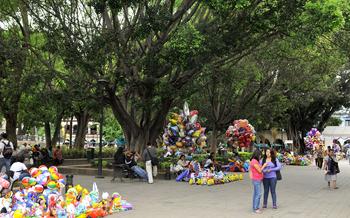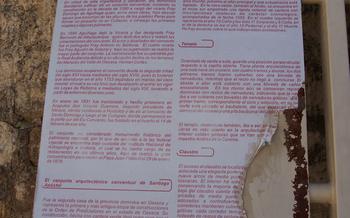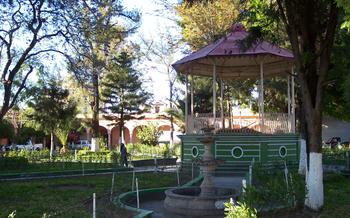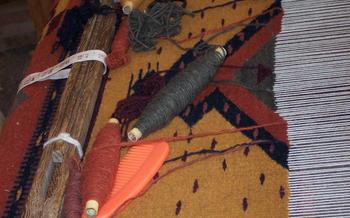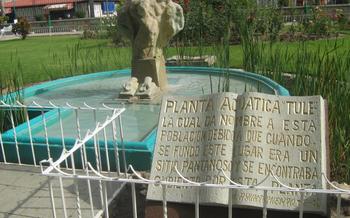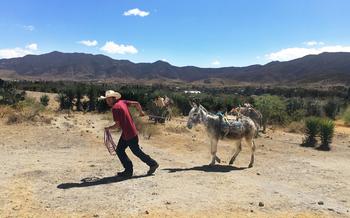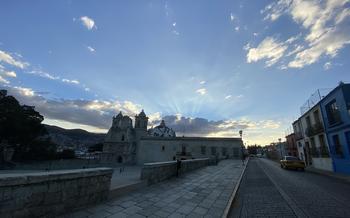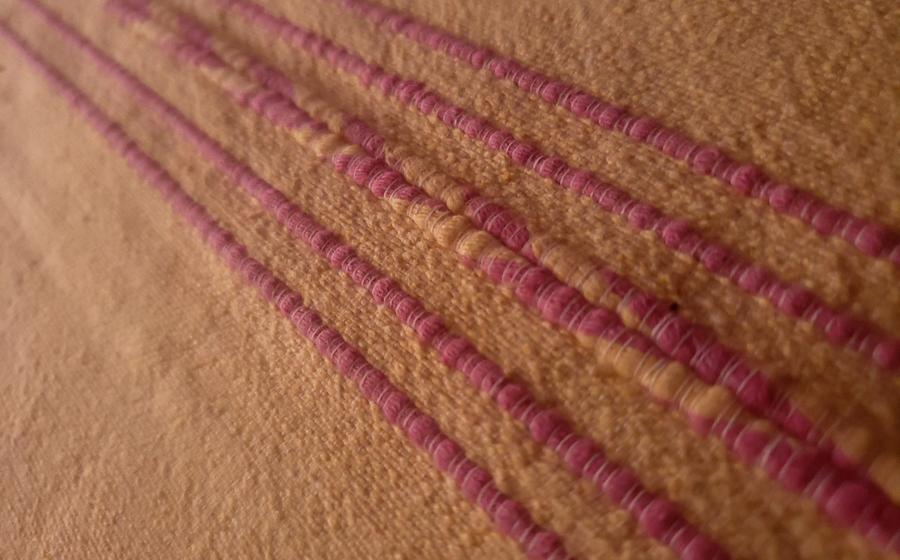
Santo Tomás Jalieza (Textile town)
- History of Santo Tomás Jalieza:
- Textile Traditions
- Visiting the Textile Workshops
- Exploring the Town
- Learning about Zapotec Culture
- Shopping for Textiles
- Visiting the Surrounding Villages
- Staying Overnight:
- Getting There:
- Planning Your Trip
- Food and Drink
- Photography Tips
History of Santo Tomás Jalieza:
Nestled in the heart of Mexico's southern state of Oaxaca, Santo Tomás Jalieza is a town steeped in rich history and cultural traditions. Its origins can be traced back to pre-Hispanic times when the Zapotec people, known for their advanced civilization, inhabited the region. During this era, the town was a thriving center for agriculture, weaving, and trade.
With the arrival of the Spanish in the 16th century, a new chapter unfolded in the town's history. The Spanish introduced textile weaving to the local population, and Santo Tomás Jalieza quickly emerged as a prominent hub for textile production. The town's artisans mastered the art of weaving, creating intricate and colorful textiles that gained renown throughout the region.
During the Mexican Revolution, Santo Tomás Jalieza played a significant role as a stronghold for the revolutionary forces. The town's strategic location and the strong sense of community among its people made it a vital base of operations for the revolutionaries.
Today, Santo Tomás Jalieza is celebrated as a leading textile center in Mexico. Its reputation for producing high-quality, handwoven textiles attracts visitors from around the world who come to witness the town's vibrant textile traditions and purchase unique and beautiful handcrafted items.
Textile Traditions
Textile weaving is deeply ingrained in the cultural identity of Santo Tomás Jalieza. The town's artisans have mastered the art of creating intricate and vibrant textiles using traditional techniques passed down through generations. The most common type of textile produced in Santo Tomás Jalieza is the rug, which is renowned for its durability, warmth, and unique designs. These rugs are often made from wool and feature geometric patterns and Zapotec symbols.
In addition to rugs, the town's weavers also create blankets, table runners, cushions, and clothing. Each textile is meticulously crafted using natural dyes derived from plants and insects. The vibrant colors and intricate designs reflect the town's rich history and Zapotec heritage. The role of women in the textile industry is particularly significant. Weaving is traditionally a female occupation, and women play a crucial role in preserving and passing on the town's textile traditions.
Visiting the Textile Workshops
Visiting the textile workshops in Santo Tomás Jalieza is an immersive experience that allows you to witness the intricate process of textile weaving firsthand. The workshops are typically small, family-run operations, where weavers work diligently at their looms, creating beautiful textiles using traditional techniques passed down through generations.
To visit a textile workshop, simply approach the weaver and ask if you can watch them work. They are usually happy to oblige and will explain the process in detail. You'll see how they select the yarn, prepare the loom, and weave the fabric, using a variety of techniques to create different patterns and designs.
Don't be shy to ask questions and interact with the weavers. They are proud of their work and are happy to share their knowledge and stories with visitors. You might even get the chance to try your hand at weaving yourself, under their expert guidance.
When it comes to purchasing textiles, be sure to inspect them carefully before making a decision. Look for high-quality materials and craftsmanship, and don't be afraid to bargain for a fair price. Remember, your purchase directly supports the local economy and helps preserve the traditional textile arts of Santo Tomás Jalieza.
Exploring the Town
Santo Tomás Jalieza offers a delightful blend of history, culture, and natural beauty. Take a leisurely stroll through the town's cobblestone streets and admire the unique Zapotec architecture, characterized by whitewashed walls, red-tiled roofs, and intricate stucco decorations. Be sure to visit the main square, the heart of the town, where you can relax under the shade of trees, admire the colonial-era buildings, and soak in the vibrant atmosphere.
Don't miss the town's church, a beautiful example of 16th-century architecture, with its ornate facade and impressive interior. Take your time to explore the narrow streets, where you'll discover hidden corners, charming cafes, and boutiques selling local handicrafts. Admire the town's vibrant street art, which depicts scenes from everyday life, Zapotec culture, and the textile industry.
If you're lucky, you might catch one of the town's festivals or events. The annual textile fair in July is a must-see, where you can witness the town's textile traditions come alive, with weavers showcasing their latest creations, live demonstrations, and traditional music and dance performances.
For a culinary treat, sample the local cuisine at one of the town's many restaurants or cafes. Savor the flavors of traditional Oaxacan dishes, such as tlayudas, tamales, and mole negro, all made with fresh, locally sourced ingredients.
Learning about Zapotec Culture
Santo Tomás Jalieza is a Zapotec town, and the Zapotec culture is an integral part of the town's identity. The Zapotecs are an indigenous people who have inhabited the Oaxaca region for centuries. They have a rich culture and history, and their traditions and customs are still very much alive in Santo Tomás Jalieza.
The Zapotec language is still spoken by many people in the town, and it is an important part of the community's identity. The Zapotec language is a tonal language, which means that the meaning of a word can change depending on the tone of voice used. This can make it a challenging language to learn for outsiders, but it is a beautiful and expressive language.
Traditional Zapotec dress is also still worn by many people in Santo Tomás Jalieza. The women's dress is typically a long, loose-fitting skirt with a blouse and a rebozo, or shawl. The men's dress is typically a white cotton shirt and pants.
The Zapotecs have a number of traditions and customs that are still practiced in Santo Tomás Jalieza. One of the most important is the Day of the Dead, which is celebrated on November 1st and 2nd. On this day, the Zapotecs honor their deceased loved ones by building altars in their homes and decorating them with flowers, food, and candles.
Shopping for Textiles
Santo Tomás Jalieza is a textile paradise, with a vast array of exquisite textiles available for purchase. From vibrant rugs and blankets to intricately woven clothing, there is something for every taste and budget. To find the best textiles, head to the local markets or visit the textile workshops directly.
When shopping for textiles in Santo Tomás Jalieza, it is important to remember that bargaining is customary. Don't be afraid to haggle with the vendors to get a fair price. However, it is also important to be respectful and remember that the weavers put a lot of time and effort into their work.
As you browse the textiles, pay attention to the quality of the materials and the workmanship. Look for textiles that are made from natural fibers, such as wool, cotton, or silk. The colors should be vibrant and the patterns should be intricate. If you are unsure about the quality of a textile, don't hesitate to ask the weaver for more information.
In addition to textiles, Santo Tomás Jalieza is also known for its unique souvenirs. You can find everything from handmade pottery and jewelry to traditional Zapotec clothing. These items make great gifts for friends and family back home.
Visiting the Surrounding Villages
Santo Tomás Jalieza is not the only textile town in the region. A short drive away, you can find other villages that are equally renowned for their textile traditions. Teotitlán del Valle is famous for its beautiful rugs, which are made using traditional Zapotec techniques. The town is also home to several art galleries and workshops, where you can learn more about the Zapotec culture and see the weavers at work.
Another nearby village worth visiting is Arrazola. This small town is known for its production of high-quality wool blankets. The blankets are made using natural dyes and traditional weaving techniques, and they are known for their durability and warmth. In Arrazola, you can visit the textile workshops and see the blankets being made, and you can also purchase blankets and other textile products directly from the weavers.
In addition to Teotitlán del Valle and Arrazola, there are several other villages in the surrounding area that are worth exploring. Each village has its own unique textile traditions and attractions, and you can easily spend several days hopping from one village to another, immersing yourself in the rich textile heritage of the region.
To get to the surrounding villages, you can either take a bus or rent a car. Buses are relatively inexpensive and easy to find, but they can be crowded and uncomfortable. Renting a car is a more expensive option, but it gives you the freedom to explore the villages at your own pace. Whichever option you choose, be sure to allow plenty of time to explore each village and meet the local weavers.
Staying Overnight:
When planning your visit to Santo Tomás Jalieza, consider staying overnight to fully immerse yourself in the town's vibrant culture. Various accommodation options are available, ranging from cozy hotels and guesthouses to traditional homestays.
Hotels in Santo Tomás Jalieza offer a comfortable and convenient stay with amenities such as private bathrooms, Wi-Fi, and air conditioning. Guesthouses provide a more intimate and local experience, often run by families who can share insights into the town's history and traditions.
For a truly authentic experience, opt for a homestay. This is an excellent way to connect with the local community and gain a deeper understanding of their daily lives. Homestays typically offer simple but comfortable accommodations and an opportunity to share meals and conversations with your hosts.
Staying overnight in Santo Tomás Jalieza allows you to experience the town's unique atmosphere after the day-trippers have departed. Stroll through the quiet streets, visit the local bars and restaurants, and enjoy the lively nightlife. It's also an excellent opportunity to witness traditional Zapotec ceremonies or celebrations that often take place in the evenings.
Whether you choose a hotel, guesthouse, or homestay, remember to book your accommodations in advance, especially during peak tourist season. This will ensure you have a place to stay and avoid any last-minute surprises.
Getting There:
To reach Santo Tomás Jalieza from Oaxaca City, you have several transportation options. The journey takes approximately 1 hour and 30 minutes, covering a distance of about 40 kilometers.
For a budget-friendly option, hop on a local bus from the central bus station (Central de Autobuses). Buses depart frequently throughout the day, and the fare is around $3-4 USD. The ride is comfortable and offers a glimpse of the countryside.
If you prefer a faster and more convenient option, consider taking a taxi. Taxis are readily available outside the bus station and at major hotels. The fare is typically around $20-25 USD, depending on your negotiation skills.
For those who prefer the freedom and flexibility of exploring at their own pace, renting a car is a great choice. Several car rental agencies operate in Oaxaca City, offering a variety of vehicles to suit different budgets and needs. The cost of renting a car ranges from $30-50 USD per day, excluding fuel.
To avoid the midday heat and crowds, aim to arrive in Santo Tomás Jalieza in the morning or late afternoon. This will allow you to make the most of your time exploring the town and its textile workshops.
Planning Your Trip
Planning a trip to Santo Tomás Jalieza requires some preparation to make the most of your visit. Here are a few tips to ensure a successful journey:
-
Best Time to Visit: The ideal time to visit Santo Tomás Jalieza is during the dry season, from November to April, when the weather is pleasant and sunny. However, the town's vibrant festivals and events, such as the Guelaguetza, which takes place in July, offer a unique cultural experience worth considering.
-
Learn Basic Spanish Phrases: While many locals in Santo Tomás Jalieza speak some English, learning a few basic Spanish phrases, such as "hello," "thank you," and "how much," can enhance your interactions with the community and show respect for their culture.
-
Pack Comfortable Shoes: Santo Tomás Jalieza is a town best explored on foot, so comfortable shoes are essential. The cobblestone streets and uneven terrain require sturdy footwear for exploring the town's hidden corners and textile workshops.
-
Plan Your Itinerary: Before your trip, create a rough itinerary to maximize your time in Santo Tomás Jalieza. Decide which textile workshops you want to visit, explore the town's landmarks, and plan excursions to nearby villages if time permits. This will help you make the most of your stay.
Food and Drink
In Santo Tomás Jalieza, your taste buds are in for a treat. The town's cuisine is a delightful blend of traditional Zapotec flavors and Mexican culinary influences. Savor the rich mole sauces, bursting with spices and aromatic herbs, which accompany many dishes. Don't miss the tlayudas, large, crispy tortillas topped with beans, cheese, and various meats or vegetables.
For a unique culinary experience, try memelas, thick, handmade tortillas filled with savory ingredients like black beans or potatoes, and topped with a tangy salsa. Indulge in enfrijoladas, corn tortillas bathed in a creamy bean sauce, or chilaquiles, crispy tortilla strips smothered in a spicy chili sauce.
Satisfy your sweet tooth with bunuelos, fried pastries coated in sugar or honey, or nicuatole, a warm, cinnamon-infused beverage made from cornmeal. And to quench your thirst, sip on refreshing tejate, a pre-Hispanic drink made from fermented corn and cacao, or try the local mezcal, a smoky, artisanal spirit.
Whether you're dining at a local restaurant, enjoying street food from a market stall, or savoring homemade dishes in a family-run eatery, the culinary delights of Santo Tomás Jalieza will leave you wanting more.
Photography Tips
Capture the Vibrant Colors of the Textiles: The textiles of Santo Tomás Jalieza are renowned for their vibrant colors. To capture the true essence of these textiles in your photographs, make sure to use a camera with good color reproduction capabilities. Experiment with different angles and lighting conditions to showcase the intricate patterns and hues of the textiles.
Photograph the Weavers at Work: The weavers of Santo Tomás Jalieza are skilled artisans who create beautiful textiles using traditional techniques. Capturing them at work is a great way to document the textile-making process and showcase the dedication and skill of the local artisans. Be respectful of their work and ask for permission before taking their photos.
Explore the Town's Unique Architecture: Santo Tomás Jalieza is home to a variety of unique architectural features, including colonial-era buildings, colorful street art, and traditional Zapotec houses. Take advantage of the town's compact size and explore the streets on foot, capturing the essence of the town's architecture and the daily life of its inhabitants.
Shoot During the Golden Hours: The golden hours, just after sunrise and just before sunset, offer the best lighting conditions for photography. During these times, the light is warm and diffused, creating a soft and flattering glow that enhances the colors and textures of your photos.
Experiment with Different Perspectives: Don't be afraid to experiment with different perspectives when photographing Santo Tomás Jalieza. Try shooting from high vantage points to capture panoramic views of the town, or get down low to capture close-ups of the intricate details of the textiles and architecture.

